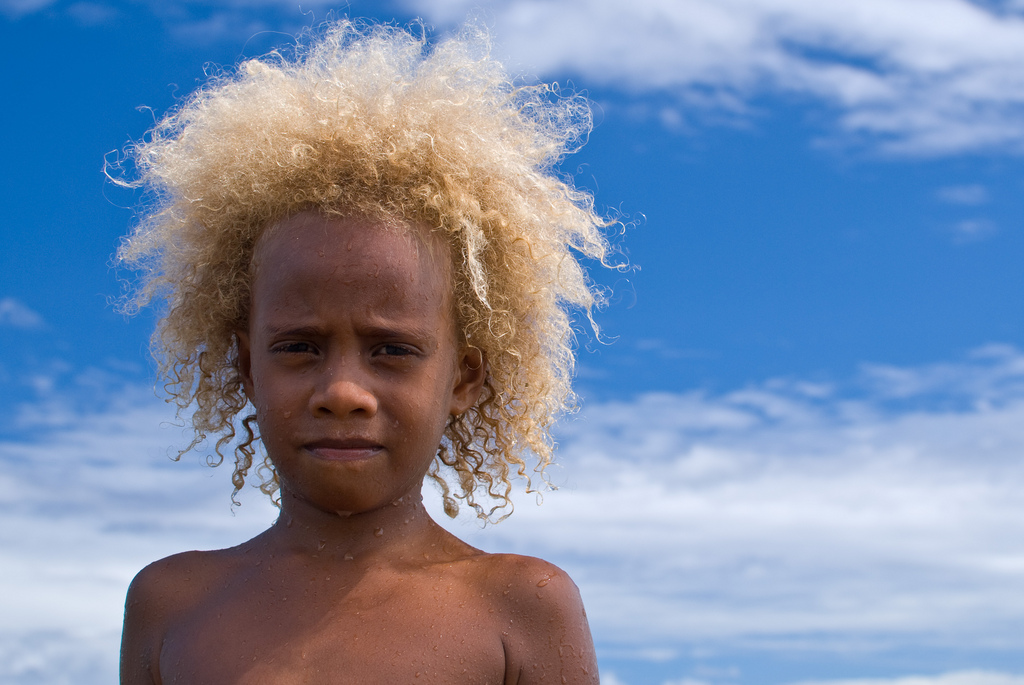The Mystery of Naturally Blonde Hair among Melanesian Population

Neucrad Health News Desk August 21, 2019
Have you ever got a chance to meet the Melanesian people of the Solomon Islands? What was the first thing that strikes your head upon meeting them? Yes. You have guessed it right. The disproportionate body colour of inhabitants of Melanesia has caught the entire world by surprise. Many people of this area have predominantly dark coloured skin and golden hair. This Solomon Island, approximately 1800 kilometres northeast of Australia in the South Pacific Ocean consists of about 10 per cent islanders sporting a rare combination of naturally blonde hair among non-Caucasian people. The Scientist community has conducted extensive research on this population to find out the exact reason behind this uncommon occurrence.
What are the Hypotheses regarding the Golden hair and Melanesian population?
Researchers have proposed various hypothesis regarding the occurrence of blonde hair among dark-skinned island inhabitants. Some scientists have previously proposed that this disproportion was due to their eating habit. They mostly consumed salt-water fishes, which bleached their hair naturally. However, modern scientists refuted this claim as the blonde hair was present in approximately 10 per cent of the population since birth. Moreover, several people in the long stretch of sea between Papua New Guinea, Vanuatu, New Caledonia, and Fiji intake a wide variety of marine fishes, but, the natural blonde hair is present only in 10 per cent of the inhabitants of Solomon Island. So the saltwater fish whitening theory could not establish the Science behind this rare fact.
Another group of researchers believed that this population has a European lineage which contributed their golden hair. Some researchers also argued that the hot climate with an abundance of sunlight bleached their hair. However, scientists could not establish any of this theory genetically.
What is the actual science behind the rare hair colour of Solomon Island inhabitants?

Recently, a renowned geneticist Sean Myles, from the prestigious Nova Scotia Agricultural College in Canada proposed a different line of finding for the golden hair. He conducted a genetic analysis on 1209 Melanesian Solomon population by collecting their saliva and hair samples. Myles experiment was based on a mixed population with brown and golden hair.
During the course of his study, he compared the genetic constituent of 43 blonde Solomon Islanders and 42 brown inhabitants in detail. The genetic analysis revealed that the island’s blonde population bore two copies of a mutant Tyrosinase-related protein 1 (TYRP1) gene. This characteristic was present in approximately 26 per cent of the island’s inhabitants. It is a unique phenomenon, and totally distinct from Caucasians; they do not show the presence of this mutant gene. Sean Myles concluded that the mutant TYRP1 gene might be the causal factor for the formation of golden hair. Scientists could also develop the same type of blonde effect in mice by intentionally mutating their gene constituents.
What is the function of the TYRP1 gene?
TYRP1 is a specific gene present in human cells which remains concerned with melanin synthesis. It is the reason that this gene is also known as the melanocyte-specific gene. In the mice, the TYRP1 gene is responsible for the dihydroxyindole carboxylic acid oxidase activity. However, the function of this gene in the production of melanocyte cells is still not clear among human beings. Scientists community are conducting more researches on this subject, to come up with some solid proofs about the working of this gene in developing golden hair among Solomon island inhabitants. Till now, the studies suggest that TYRP1 helps in maintaining the melanosome structure. Mutation in this gene can lead to melanocyte cell death.
Stay glued to Neucrad Health-Science Infomedia for more such interesting stories and their scientific analysis.








